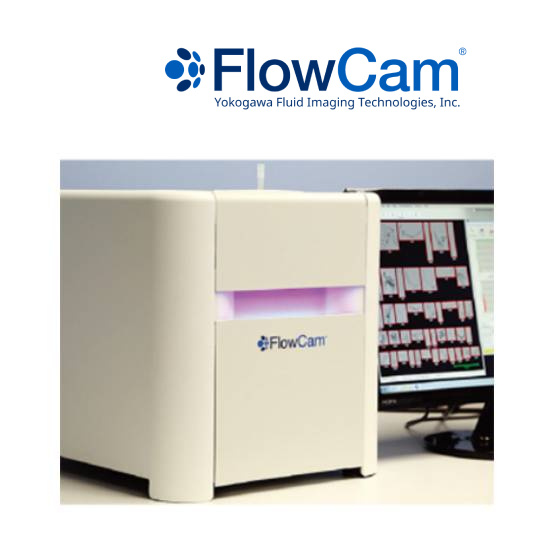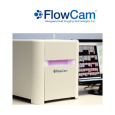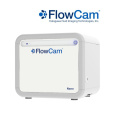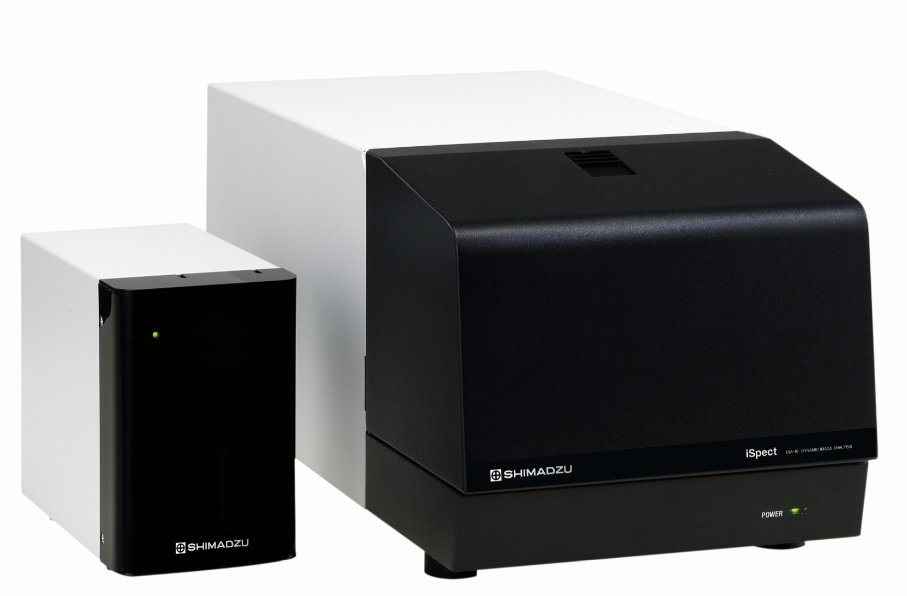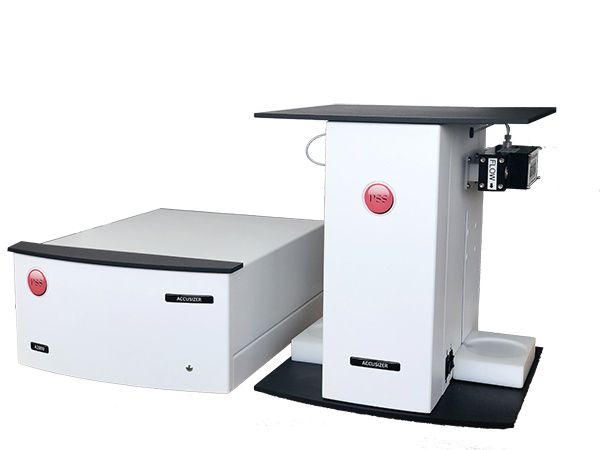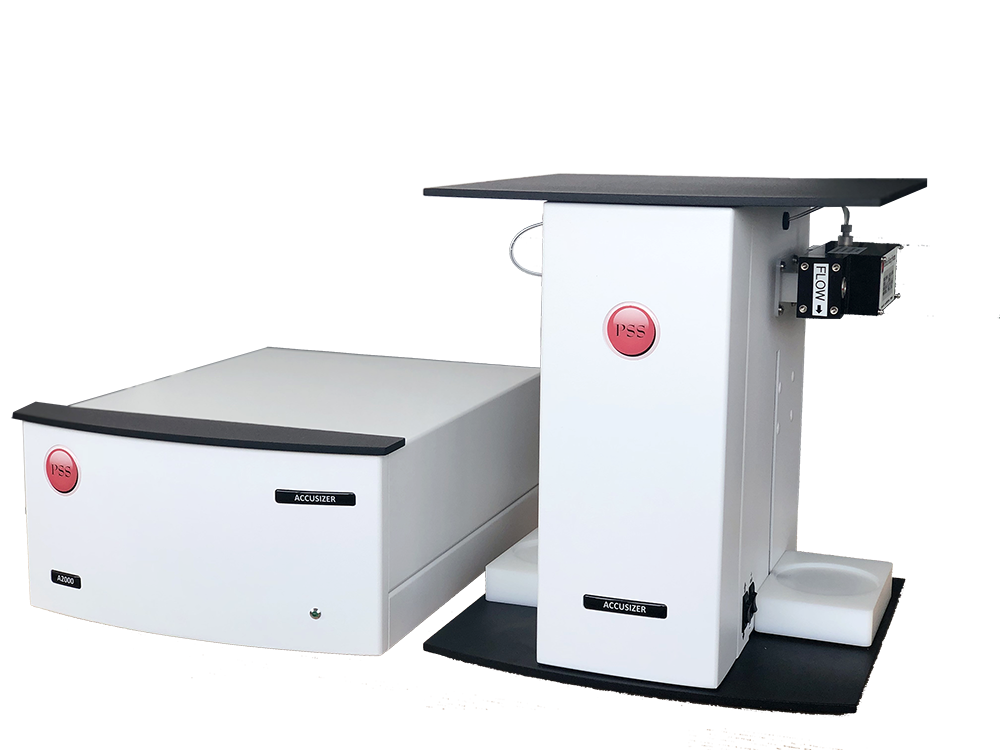方案详情
文
什么是阈值? 阈值处理是一种在图像处理中使用的图像分割方法,用于从背景中辨别对象的边界的方法。 当阈值缺失或配置不当时,大多数成像颗粒分析仪经常对半透明粒子(例如蛋白质聚集体)进行错误表征或甚至未检测到。
大多数成像粒子分析仪提供的暗像素阈值处理,当它比成像背景更亮时,无法识别颗粒物质。 利用暗阈值和亮阈值可以检测和识别表现出不透明度范围的颗粒(透明不透明),并提高颗粒分析仪检测,成像和分析半透明颗粒的能力。
方案详情

A WHITE PAPER AWHITE PAPER The Benefits of Light and Dark PixelThresholding WHAT IS THRESHOLDING? Thresholding is a method of image segmentation used in imageprocessing to discern the boundaries of an object from its background.Semi-transparent particles, such as protein aggregates,are oftenmischaracterized or even undetected by most imaging particle analyzerswhen thresholding is missing or improperly configured. Dark pixel thresholding, offered by most imaging particle analyzers, fails todiscern particulate matter when it is lighter than the imaged background.Utilization of both dark and light pixel thresholding enables the detectionand discernment of particulates expressing ranges in opacity (opaque totransparent) and improves the particle analyzer's ability to detect, image,and analyze semi-transparent particles. A protein sample was analyzed using dark pixel thresholdingand both dark and light pixel thresholding. Utilization of darkand light thresholding showed an increase in particle countin all size bins. Learn how the FlowCam uses light and darkthresholding at www.fluidimaging.com/resources/tech-briefs HOW DOES THRESHOLDING AFFECTINSTRUMENT SENSITIVITY? Thresholding uses pixel intensities to differentiate the boundaries of the object from its background. Each pixel in thegrayscale image is assigned an intensity value from 0 (black) to 255 (white). Color images are converted to grayscale imagesprior to intensity assignments. The intensity of each pixel in the image is compared to the background pixel intensity andthe thresholding value. Based on these comparisons, the pixel is determined to be part of either the foreground object orthe background. Dark pixel thresholding recognizes objects with pixel intensities darker than the background. Light anddark pixel thresholding recognizes objects with pixel intensities lighter and/or darker than their background. This is ideal for.transparent/semi-transparent particles such as protein aggregates. In most particle analyzers, opaque particles are darker than their background as viewed by the camera because theillumination source is located behind the flow cell. For this reason, most imaging particle analyzers use dark pixelthresholding only. However, dark pixel thresholding of semi-transparent particles, such as protein aggregates, often leadsto fractionation into several smaller particles which results in inaccurate physical measurements and particle count. Useof both dark and light pixel thresholding during particle analysis recognizes the grayscale range (opaque to transparent) ofsemi-transparent particles, reduces fractionation, and improves particle count and morphological characterization. THE BENEFIT OF DUAL THRESHOLDING 1. Raw ImageNo detection 2. Dark Threshold Only Using 25 Grey intensitylevels (3 medium/35 small particles) 3. Dark Threshold Only 4. Light Threshold Only 15 Grey intensity levels More large particles 15 Grey intensity levels(4 Medium/42 small particles) detected than previous (6 medium/8 small) 5. Dark and Light Threshold Both 15 Grey intensity levels(1 large/28 small) 6. Dark Threshold and Light Threshold-Both 15 Grey intensity levels+VisualSpreadsheet(One large particle- best characterization ofthis protein) The figure above illustrates particle analysis of a semi-transparent particle using various threshold settings. These imageswere obtained using the FlowCam particle analyzer, which has dark and/or light pixel thresholding capabilities. Eachgreen box delineates a separate particle, as identifed by the FlowCam's analysis software VisualSpreadsheet, and portionsidentified as part of each particle are colored red. The use of onlyone pixel setting (either light or dark) resulted in the fractionation of the protein aggregate into as manyas 46 separate particles. As image 1 shows, the protein aggregate analyzed was comprised of portions darker and lighterthan the image background. When dark pixel thresholding was used, only the portions of the protein darker than thebackground were recognized as particulate matter, and the protein was falsely subdivided into several smaller particles(images 2 and 3). When light pixel thresholding was used, only portions of the particle lighter than the background wererecognized as particulate matter and the protein was also falsely subdivided into several smaller particles (image 4).Changes in opacity of the protein aggregate result in changes in grayscale intensity. The application of only a single type ofpixel thresholding (dark or light) failed to accurately analyze a particle exhibiting both light and dark portions. The use of both dark and light pixel settings, in conjunction with VisualSpreadsheet's neighborhood analysis feature,resulted in accurate particle characterization of the protein aggregate. When dark and light pixel thresholding was used, theparticle analyzer recognized both dark and light portions of the particle as particulate matter. The filamentous nature of thisprotein, however, resulted in minor fractionation of the aggregate (image 5).When the software's neighborhood analysiswas applied, the whole protein (both light and dark portions) was recognized as a single particle (image 6). Dark and light pixel thresholding and VisualSpreadsheet's neighborhood analysis are necessary to accurately analyze semi-transparent particles. Read Fluid Imaging Technologies’Technical Brief to learn how to modify threshold settings on theFlowCam, use VisualSpreadhseet, and optimize analysis of any particulate matter at www.fluidimaging.com/resources/tech-briefs. CONTINUED ON REVERSE FLUID IMAGINGTECHNOLOGIES, INC.+-ontact@fluidimaging.comwww.fluidimaging.comParticle analysis with vision 什么是阈值? 阈值处理是一种在图像处理中使用的图像分割方法,用于从背景中辨别对象的边界的方法。 当阈值缺失或配置不当时,大多数成像颗粒分析仪经常对半透明粒子(例如蛋白质聚集体)进行错误表征或甚至未检测到。大多数成像粒子分析仪提供的暗像素阈值处理,当它比成像背景更亮时,无法识别颗粒物质。 利用暗阈值和亮阈值可以检测和识别表现出不透明度范围的颗粒(透明不透明),并提高颗粒分析仪检测,成像和分析半透明颗粒的能力。
确定
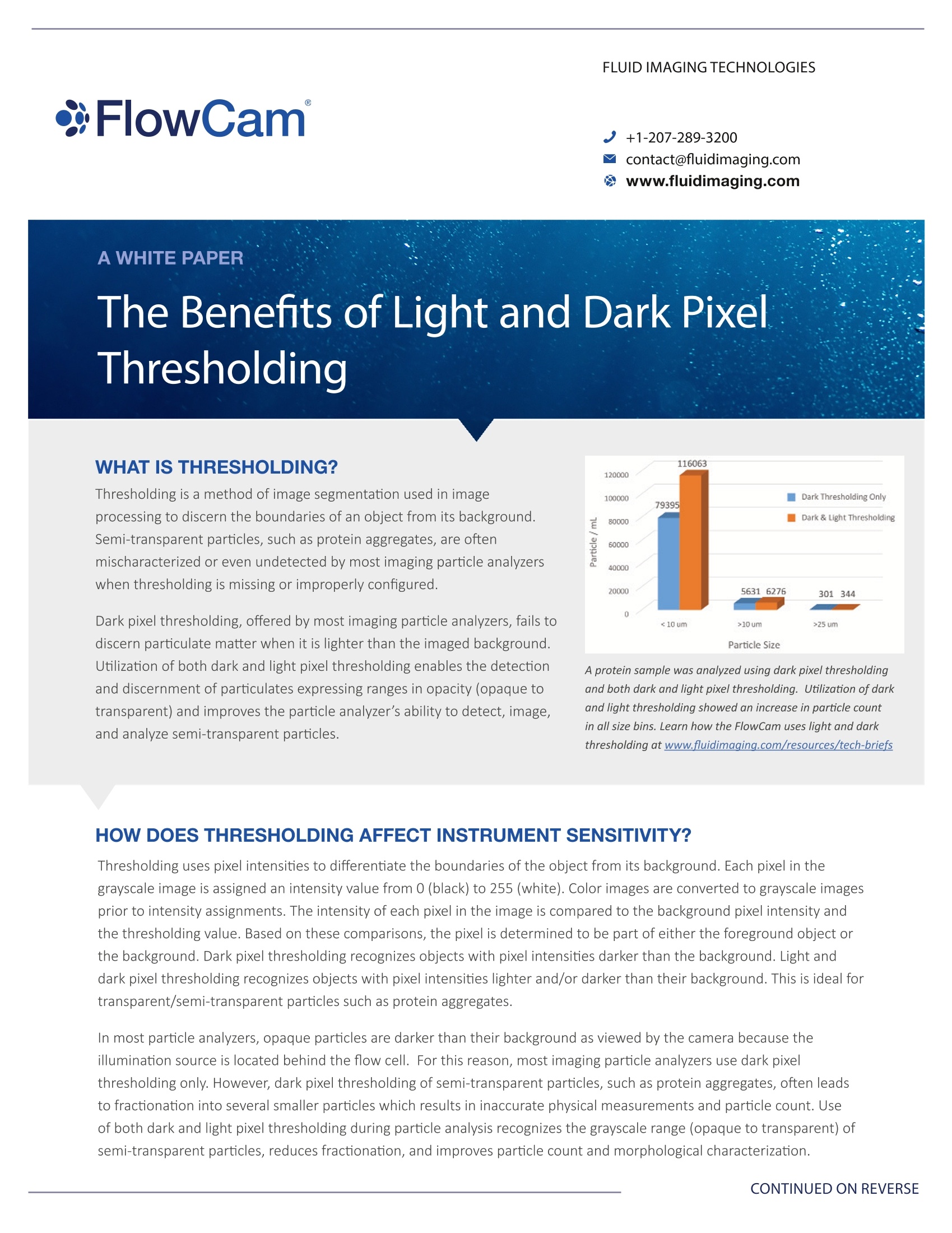
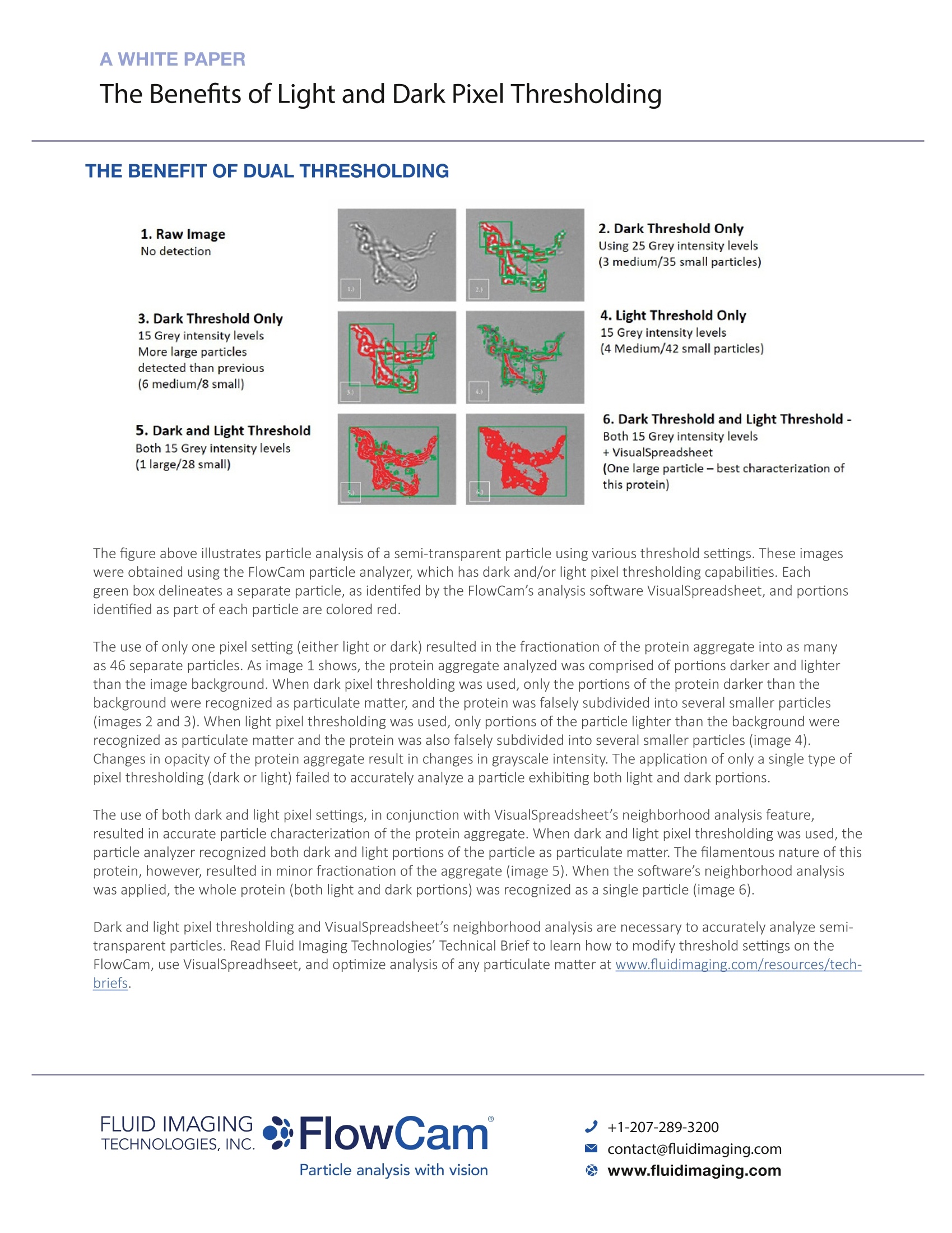
还剩1页未读,是否继续阅读?
大昌华嘉科学仪器为您提供《颗粒表征中阈值处理影响检测方案(图像粒度粒形)》,该方案主要用于其他中阈值处理影响检测,参考标准--,《颗粒表征中阈值处理影响检测方案(图像粒度粒形)》用到的仪器有流式颗粒成像分析系统FlowCam®8100、颗粒成像法+光阻法分析系统 FlowCam® + LO、纳米流式颗粒成像分析系统 FlowCam® Nano
推荐专场
相关方案
更多
该厂商其他方案
更多

